Solar Energy
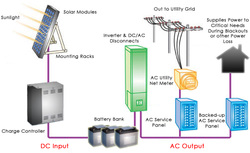
The Earth, in orbit around the sun, intercepts a very small part of the sun’s immense output. On Earth, direct sunlight
is available from sunrise until sunset, except during solar eclipses. Solar collectors and modules are designed to capture some of the sun’s energy and change it from radiation into more usable forms such as heat or electricity. In fact, sunlight is an excellent source of heat and electricity, the two most important forms of energy we consume. Solar energy is becoming increasingly popular for remote power needs such as telecommunication towers, agricultural applications(irrigation and pasture management), in tropical countries that are not connected to an electrical grid,for heating swimming pools, and many other applications around the world.
is available from sunrise until sunset, except during solar eclipses. Solar collectors and modules are designed to capture some of the sun’s energy and change it from radiation into more usable forms such as heat or electricity. In fact, sunlight is an excellent source of heat and electricity, the two most important forms of energy we consume. Solar energy is becoming increasingly popular for remote power needs such as telecommunication towers, agricultural applications(irrigation and pasture management), in tropical countries that are not connected to an electrical grid,for heating swimming pools, and many other applications around the world.
Wind Energy
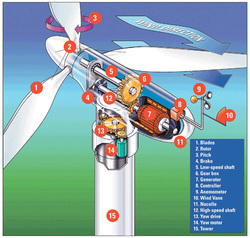
Using the wind to create electricity has been around for a long time - you've probably seen windmills on farms. When the wind turns the blades of a windmill, it spins a turbine inside a small generator to produce electricity, just like a big coal power plant. A windmill on a farm can make only a small amount of electricity - enough to power a few farm machines. To make enough electricity to serve lots of people, power companies build "wind farms" with dozens of huge wind turbines.
A wind turbine works the opposite of a fan. Instead of using electricity to make wind, a turbine uses wind to make electricity.
The wind turns the blades, which spin a shaft, which connects to a generator and makes electricity. The electricity is sent through transmission and distribution lines to a substation, then on to homes, business and schools.
A wind turbine works the opposite of a fan. Instead of using electricity to make wind, a turbine uses wind to make electricity.
The wind turns the blades, which spin a shaft, which connects to a generator and makes electricity. The electricity is sent through transmission and distribution lines to a substation, then on to homes, business and schools.
Hydro Power
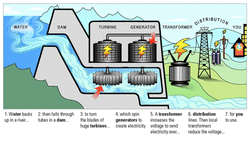
Humans have used water power to supply energy for almost as long as we’ve used wind. Archaeologists have discovered descriptions of water wheels used for grinding grain that date back to more than 3,000 years ago. Today, the energy of falling water is used mainly to drive electrical generators at hydroelectric dams. As long as snow and rainfall can fi ll the streams and rivers, moving water can be a renewable source of
energy.
energy.
Geothermal Energy
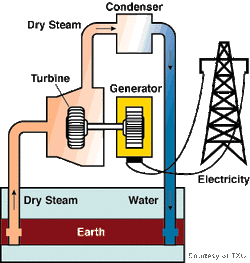
"Geo" means "from the earth," and "thermal" means "heat," so this type of energy is found under the earth. The hot lava from a volcano and the hot steam from a geyser both come from underground heat - and we can use that same type of heat in our homes.
Here's how it works: about four feet underground, the temperature of the earth stays the same all year long - about 55 degrees.
A geothermal heating system uses pipes buried more than four feet deep in the earth.
Biomass energy
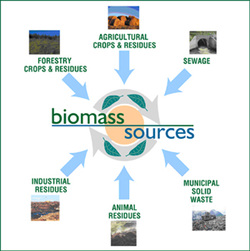
The term “biomass” refers to any form of plant or animal tissue. In the energy industry, biomass refers to wood, straw, biological waste products such as manure, and other natural materials that contain stored energy. The energy stored in biomass can be
released by burning the material directly, or by feeding it to micro-organisms that use it to make biogas, a form of natural gas. Energy from biomass is still used around the world, for everything from cooking and heating to generating electricity.
released by burning the material directly, or by feeding it to micro-organisms that use it to make biogas, a form of natural gas. Energy from biomass is still used around the world, for everything from cooking and heating to generating electricity.